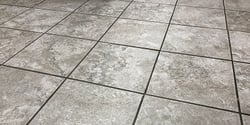
For a quality flooring project, you need to start at the bottom. Underlayment masks imperfections in the subfloor, reduces sound, and provides other benefits specific to each type of floor covering. Choosing the right product to go underneath is important to having a finished floor that’s not only beautiful but will last for many years.
What is Underlayment?
If you tear up flooring, you will likely find many layers. Underneath the top floor covering is the underlay, the layer of material directly beneath. Under that, you would find a subfloor such as OSB (oriented strand board), plywood or concrete. In certain cases, you could also find moisture and/or vapor barriers among the layers. In the event of an old building, you might find multiples of any of these!
Each type of flooring requires an underlayment that is optimized for the specific material, which will affect the performance and durability. The underlayment you choose might be a hard surface like plywood or cement board or soft like felt or carpet padding.
What is the Best Underlayment for Each Flooring Type?
Wood
Wood flooring includes a wide range of materials, such as oak, hickory, maple and ash as well as exotic varieties. Also part of this category is engineered flooring, which has a layer of solid hardwood on top and layers of composite material underneath.
When installing a wood floor, major concerns would be controlling the moisture and acoustics. This means taking into consideration the type of wood, the geography, and the climate where your project is located.
Felt Hardwood Floor Underlayment is the most common hardwood flooring underlayment. The felt is very dense and does offer some protection from moisture from below, however if it’s in a very humid area, an additional moisture barrier should be used.
Cork Hardwood Floor Underlayment is a natural choice to support wood as an isolation barrier to dampen impact noise going from an upper living area to a lower living area. For the most part, wood should be allowed to breathe and not used with a moisture barrier unless the situation requires it.
Regardless of underlayment, solid hardwood shouldn’t be installed in basements or damp areas.
Tile
The underlayment used for tile needs to provide firm support to prevent the tile or grout from cracking when walked on. The material also needs to have flexibility so it can absorb the expansion and contraction that happens as the temperature fluctuates.
There are two types of materials that work well for this situation:
Cement Board Underlayment (CBU), also commonly referred to as cement backer board, is made from cement material and wood or cellulose fibers. The fibers make the cement board stronger and let it be flexible enough to move without cracking.
DITRA Uncoupling Membrane is made from polyethylene and has a grid structure of square cavities that allows the tile mortar to bond to the tile and anchor it to the cavity. This membrane allows for the movement of the tile as it expands and contracts so that it doesn’t crack. This product also serves as a great moisture barrier.
Laminate Flooring
Laminate flooring is an alternative to wood or tile that comes in a large array of styles and is generally more affordable. Sometimes the laminate product will come with an underlayment attached, which makes installing it very easy. If your version doesn’t come with it already, here are two to consider.
Acoustical Laminate Underlayment is made of cork or felt. The softer surface acts as a moisture barrier while at the same time minimizing the noise from footsteps.
Foam Laminate Underlayment is the most common option. It can come as a combination with or without a moisture barrier. You should use a combination product when installing in an area like a basement or bathroom where high humidity is more likely. Foam is also excellent at padding the floor and softening the noise.
Keep in mind that the squeaks, creaks, and groans heard from any floors are caused by movements, and micro movements, of the components. The trick to avoiding these noises is the use of proper fasteners and techniques, like the SCRAIL® SubLoc® PRO, at installation to prevent movement from happening. The upper threads of SCRAIL® SubLoc® PRO grab into the board and prevent micro movement of the wood even in the event of wood shrinkage. No smooth shank between the upper and lower threads prevents board movement that can lead to squeaking and creaking. Download the Whitepaper: 3 steps to ensure a squeakless floor to learn how to ensure a quality installation that lasts.
.svg.png)

